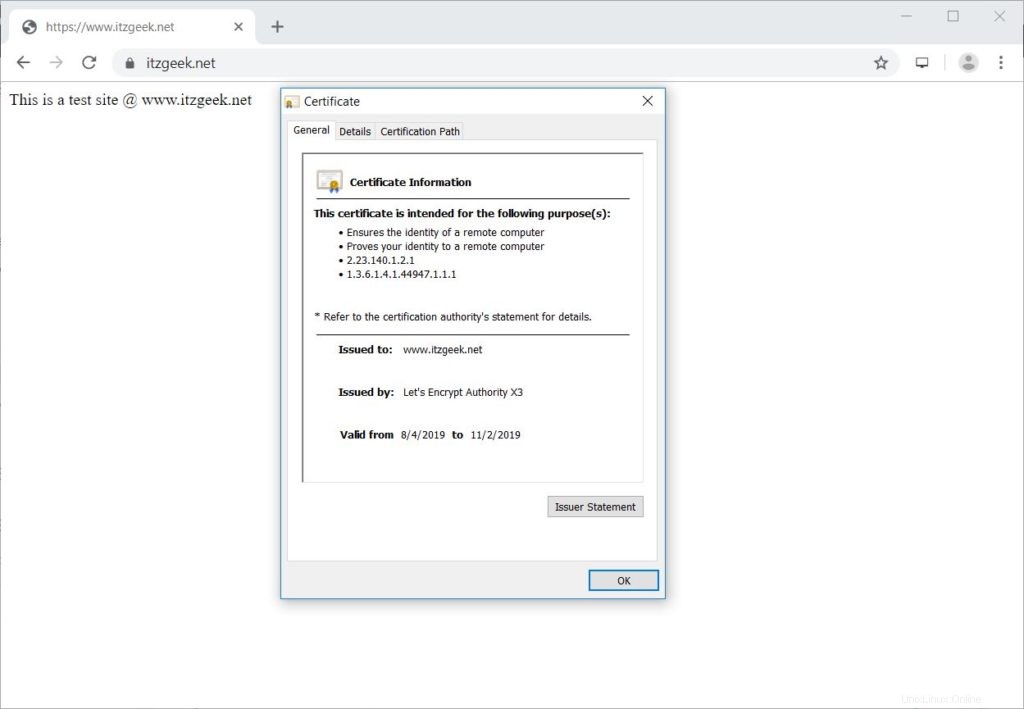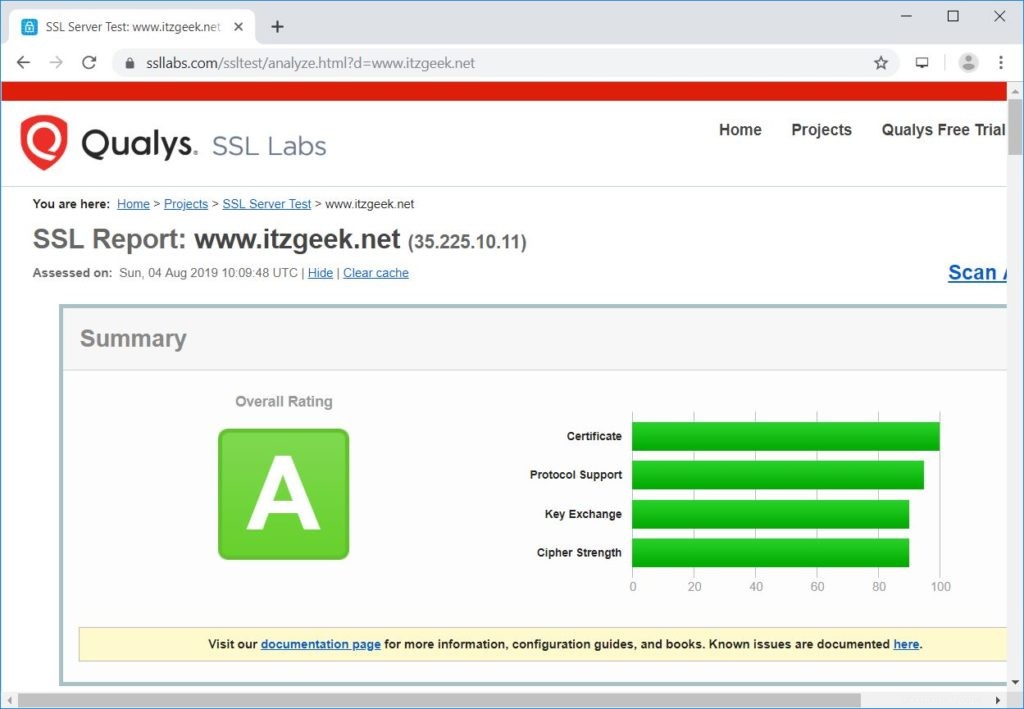Let's Encrypt è un'autorità di certificazione che fornisce certificati SSL gratuiti per i siti Web per abilitare la crittografia TLS. È stato lanciato nell'aprile 2016.
Let's Encrypt automatizza il processo di creazione, convalida, firma, implementazione e rinnovo dei certificati per siti Web sicuri.
Attualmente, Let's encrypt supporta l'emissione di certificazioni automatizzate per Apache, Nginx, Plex e Haproxy.
Prerequisiti
Dovresti avere uno stack LEMP configurato sul tuo sistema RHEL / CentOS.
LEGGI :Come installare lo stack LEMP su CentOS 8 / RHEL 8
LEGGI: Come installare lo stack LEMP su CentOS 7 / RHEL 7
Installa Certbot
Per generare un certificato Let's Encrypt per il tuo dominio, dovresti avere l'accesso al terminale e il client Certbot ACME installato sul tuo sistema. Gestisce l'emissione di certificati e aggiorna la configurazione di Nginx per utilizzare il certificato creato senza tempi di inattività.
Certbot è disponibile sul repository EPEL solo per CentOS 7 / RHEL 7. Quindi, dobbiamo scaricare manualmente il programma di installazione di Certbot per CentOS 8 / RHEL 8 dal suo sito ufficiale.
### CentOS 8 / RHEL 8 ### curl -O https://dl.eff.org/certbot-auto mv certbot-auto /usr/local/bin/certbot-auto chmod 0755 /usr/local/bin/certbot-auto ### CentOS 7 ### rpm -ivh https://dl.fedoraproject.org/pub/epel/epel-release-latest-7.noarch.rpm yum install -y certbot python2-certbot-nginx ### RHEL 7 ### rpm -ivh https://dl.fedoraproject.org/pub/epel/epel-release-latest-7.noarch.rpm subscription-manager repos --enable rhel-7-server-optional-rpms yum install -y certbot python2-certbot-nginx
Crea host virtuale
Creeremo ora un file di configurazione dell'host virtuale (blocco server) per il dominio www.itzgeek.net.
Questo blocco server serve la versione HTTP del tuo dominio.vi /etc/nginx/conf.d/www.itzgeek.net.conf
Usa le informazioni di seguito.
server {
server_name www.itzgeek.net;
root /opt/nginx/www.itzgeek.net;
location / {
index index.html index.htm index.php;
}
access_log /var/log/nginx/www.itzgeek.net.access.log;
error_log /var/log/nginx/www.itzgeek.net.error.log;
location ~ \.php$ {
include /etc/nginx/fastcgi_params;
fastcgi_pass 127.0.0.1:9000;
fastcgi_index index.php;
fastcgi_param SCRIPT_FILENAME $document_root$fastcgi_script_name;
}
} Crea una radice del documento per posizionare i tuoi file HTML.
mkdir -p /opt/nginx/www.itzgeek.net
Modifica l'autorizzazione della directory.
chown -R nginx:nginx /opt/nginx/www.itzgeek.net
Inserisci il file HTML di prova nella radice del documento del tuo dominio web.
echo "This is a test site @ www.itzgeek.net" > /opt/nginx/www.itzgeek.net/index.html
Riavvia il servizio Nginx.
systemctl restart nginx
Crea / Aggiorna record DNS
Accedi al tuo strumento di gestione DNS o registrar di domini e crea un record A/CNAME per il dominio. Es:www.itzgeek.net.

Attendi un po' di tempo per consentire la propagazione del record.
Controlla la propagazione DNS con l'utilità Nslookup yum install -y bind-utils.

Installa il certificato Let's Encrypt
Usa il comando certbot per creare e installare il certificato Let's Encrypt.
### CentOS 8 / RHEL 8 ### /usr/local/bin/certbot-auto --nginx ### CentOS 7 / RHEL 7 ### certbot --nginx
Segui il prompt interattivo e genera e installa il certificato.
Saving debug log to /var/log/letsencrypt/letsencrypt.log Plugins selected: Authenticator nginx, Installer nginx Enter email address (used for urgent renewal and security notices) (Enter 'c' to cancel): [email protected] << Email Address to receive renewal/security notification - - - - - - - - - - - - - - - - - - - - - - - - - - - - - - - - - - - - - - - - Please read the Terms of Service at https://letsencrypt.org/documents/LE-SA-v1.2-November-15-2017.pdf. You must agree in order to register with the ACME server at https://acme-v02.api.letsencrypt.org/directory - - - - - - - - - - - - - - - - - - - - - - - - - - - - - - - - - - - - - - - - (A)gree/(C)ancel: A << Access Terms and Conditions - - - - - - - - - - - - - - - - - - - - - - - - - - - - - - - - - - - - - - - - Would you be willing to share your email address with the Electronic Frontier Foundation, a founding partner of the Let's Encrypt project and the non-profit organization that develops Certbot? We'd like to send you email about our work encrypting the web, EFF news, campaigns, and ways to support digital freedom. - - - - - - - - - - - - - - - - - - - - - - - - - - - - - - - - - - - - - - - - (Y)es/(N)o: Y << Subscribe to Newsletter Which names would you like to activate HTTPS for? - - - - - - - - - - - - - - - - - - - - - - - - - - - - - - - - - - - - - - - - 1: www.itzgeek.net - - - - - - - - - - - - - - - - - - - - - - - - - - - - - - - - - - - - - - - - Select the appropriate numbers separated by commas and/or spaces, or leave input blank to select all options shown (Enter 'c' to cancel): 1 << Choose domain name to generate certificate Obtaining a new certificate Performing the following challenges: http-01 challenge for www.itzgeek.net Waiting for verification... Cleaning up challenges Deploying Certificate to VirtualHost /etc/nginx/conf.d/www.itzgeek.net.conf Please choose whether or not to redirect HTTP traffic to HTTPS, removing HTTP access. - - - - - - - - - - - - - - - - - - - - - - - - - - - - - - - - - - - - - - - - 1: No redirect - Make no further changes to the webserver configuration. 2: Redirect - Make all requests redirect to secure HTTPS access. Choose this for new sites, or if you're confident your site works on HTTPS. You can undo this change by editing your web server's configuration. - - - - - - - - - - - - - - - - - - - - - - - - - - - - - - - - - - - - - - - - Select the appropriate number [1-2] then [enter] (press 'c' to cancel): 2 << Redirect traffic from HTTP to HTTPS Redirecting all traffic on port 80 to ssl in /etc/nginx/conf.d/www.itzgeek.net.conf - - - - - - - - - - - - - - - - - - - - - - - - - - - - - - - - - - - - - - - - Congratulations! You have successfully enabled https://www.itzgeek.net You should test your configuration at: https://www.ssllabs.com/ssltest/analyze.html?d=www.itzgeek.net - - - - - - - - - - - - - - - - - - - - - - - - - - - - - - - - - - - - - - - - IMPORTANT NOTES: - Congratulations! Your certificate and chain have been saved at: /etc/letsencrypt/live/www.itzgeek.net/fullchain.pem Your key file has been saved at: /etc/letsencrypt/live/www.itzgeek.net/privkey.pem Your cert will expire on 2019-11-02. To obtain a new or tweaked version of this certificate in the future, simply run certbot-auto again with the "certonly" option. To non-interactively renew *all* of your certificates, run "certbot-auto renew" - Your account credentials have been saved in your Certbot configuration directory at /etc/letsencrypt. You should make a secure backup of this folder now. This configuration directory will also contain certificates and private keys obtained by Certbot so making regular backups of this folder is ideal. - If you like Certbot, please consider supporting our work by: Donating to ISRG / Let's Encrypt: https://letsencrypt.org/donate Donating to EFF: https://eff.org/donate-le
Reindirizza le richieste HTTP non www a www HTTPS con Nginx (opzionale)
Ora configureremo il server Nginx per reindirizzare il traffico proveniente dal sito HTTP non www al sito HTTPS WW, ovvero http://itzgeek.net>> https://www.itzgeek.net .
Qui utilizzeremo lo stesso file di configurazione che abbiamo creato per la versione HTTP del sito per eseguire il reindirizzamento del sito HTTP non www al reindirizzamento HTTPS WW.
vi /etc/nginx/conf.d/www.itzgeek.net.conf
Aggiungi le seguenti informazioni alla fine del file.
# Redirect NON-WWW HTTP to WWW HTTPS
server {
if ($host = itzgeek.net) {
return 301 https://www.itzgeek.net$request_uri;
}
server_name itzgeek.net;
listen 80;
return 404;
}
Riavvia il servizio Nginx.
systemctl restart nginx
Firewall
Configura il firewall per consentire le richieste HTTPS.
firewall-cmd --permanent --add-port=443/tcp firewall-cmd --reload
Verifica certificato Let's Encrypt
Verifica i dettagli del certificato Let's Encrypt andando alla versione HTTPS del tuo sito web.
http://il-tuo-http-sito-webO
https://tuo-https-sito-web
Test del certificato SSL
Controlla il tuo certificato SSL per eventuali problemi e le relative valutazioni di sicurezza andando all'URL sottostante.
https://www.ssllabs.com/ssltest/analyze.html?d=www.itzgeek.net
Rinnova il certificato Let's Encrypt
Il certificato Let's Encrypt ha una validità di 90 giorni e deve essere rinnovato prima della scadenza.
Per impostazione predefinita, sia CentOS 7 che RHEL 7 sono configurati con la voce cron scheduler che viene eseguita due volte al giorno per rinnovare il certificato Let's Encrypt.
Sfortunatamente, per CentOS 8 / RHEL 8, è necessario configurare manualmente lo scheduler cron.
echo "0 0,12 * * * root python -c 'import random; import time; time.sleep(random.random() * 3600)' && /usr/local/bin/certbot-auto renew" | sudo tee -a /etc/crontab > /dev/null
Puoi anche simulare il processo di rinnovo del certificato con il comando seguente per assicurarti che il rinnovo proceda senza intoppi.
### CentOS 8 / RHEL 8 ### /usr/local/bin/certbot-auto renew --dry-run ### CentOS 7 / RHEL 7 ### certbot renew --dry-run
Risultato:
Saving debug log to /var/log/letsencrypt/letsencrypt.log - - - - - - - - - - - - - - - - - - - - - - - - - - - - - - - - - - - - - - - - Processing /etc/letsencrypt/renewal/www.itzgeek.net.conf - - - - - - - - - - - - - - - - - - - - - - - - - - - - - - - - - - - - - - - - Cert not due for renewal, but simulating renewal for dry run Plugins selected: Authenticator nginx, Installer nginx Renewing an existing certificate Performing the following challenges: http-01 challenge for www.itzgeek.net Waiting for verification... Cleaning up challenges - - - - - - - - - - - - - - - - - - - - - - - - - - - - - - - - - - - - - - - - new certificate deployed with reload of nginx server; fullchain is /etc/letsencrypt/live/www.itzgeek.net/fullchain.pem - - - - - - - - - - - - - - - - - - - - - - - - - - - - - - - - - - - - - - - - - - - - - - - - - - - - - - - - - - - - - - - - - - - - - - - - - - - - - - - - ** DRY RUN: simulating 'certbot renew' close to cert expiry ** (The test certificates below have not been saved.) Congratulations, all renewals succeeded. The following certs have been renewed: /etc/letsencrypt/live/www.itzgeek.net/fullchain.pem (success) ** DRY RUN: simulating 'certbot renew' close to cert expiry ** (The test certificates above have not been saved.) - - - - - - - - - - - - - - - - - - - - - - - - - - - - - - - - - - - - - - - - IMPORTANT NOTES: - Your account credentials have been saved in your Certbot configuration directory at /etc/letsencrypt. You should make a secure backup of this folder now. This configuration directory will also contain certificates and private keys obtained by Certbot so making regular backups of this folder is ideal.
Se l'output non segnala alcun problema, il rinnovo del certificato funzionerà come previsto.
Conclusione
È tutto. Spero che tu abbia imparato a configurare Let's Encrypt SSL Certificate con Nginx su CentOS 8 / RHEL 8 e CentOS 7 / RHEL 7. Condividi il tuo feedback nella sezione commenti.